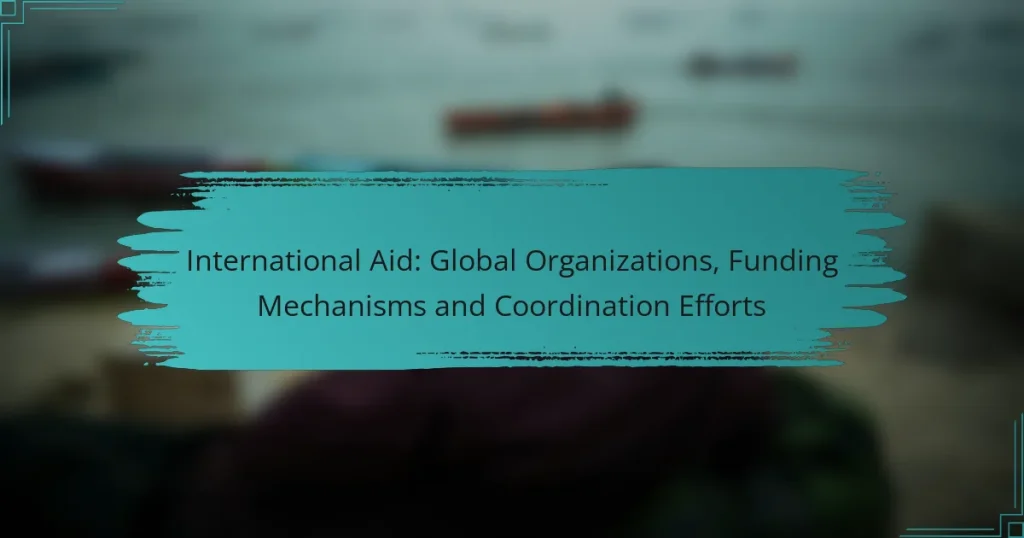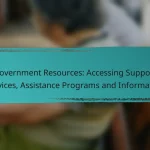International aid is a complex ecosystem involving key global organizations that address humanitarian crises and promote development through distinct missions and funding mechanisms. Funding primarily comes from bilateral and multilateral sources, private donations, and financial instruments such as grants and loans, all crucial for supporting various initiatives. Effective coordination among stakeholders is essential to streamline resource allocation and enhance the impact of aid interventions on affected populations.
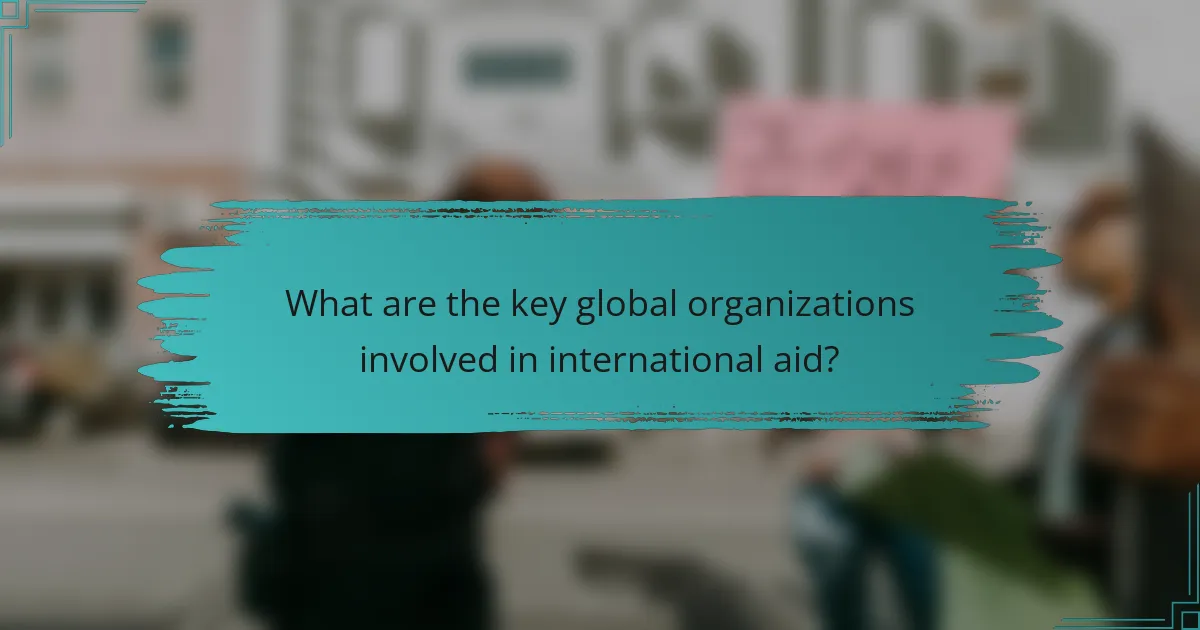
What are the key global organizations involved in international aid?
Several key global organizations play vital roles in international aid, each with distinct missions and funding mechanisms. These organizations work collaboratively to address humanitarian crises, promote development, and provide essential resources to affected populations.
United Nations (UN)
The United Nations is a leading global organization in international aid, coordinating efforts among member states and various agencies. Its agencies, such as the UN Development Programme (UNDP) and the UN Children’s Fund (UNICEF), focus on development, humanitarian assistance, and human rights.
The UN mobilizes funding through member contributions and partnerships with private organizations. Programs often target poverty reduction, education, and health improvements, aiming to achieve sustainable development goals (SDGs) globally.
World Bank
The World Bank provides financial and technical assistance to developing countries for projects that aim to reduce poverty and promote economic development. It offers loans, grants, and expertise to support infrastructure, health, and education initiatives.
Funding from the World Bank typically comes with specific conditions and is aimed at long-term development. Countries can access resources through various programs, including the International Development Association (IDA) for low-income nations.
International Red Cross
The International Red Cross focuses on humanitarian aid, disaster response, and health services during emergencies. It operates globally, providing immediate assistance in crises such as natural disasters, armed conflicts, and health emergencies.
Through its network of national societies, the International Red Cross mobilizes volunteers and resources to deliver aid effectively. It emphasizes neutrality and impartiality, ensuring that assistance reaches those in need regardless of their circumstances.
Oxfam
Oxfam is a confederation of NGOs that works to alleviate global poverty and promote social justice. It engages in development programs, emergency response, and advocacy to influence policy changes that benefit disadvantaged communities.
Oxfam’s funding comes from donations, grants, and partnerships, allowing it to implement projects focused on education, health, and livelihoods. The organization emphasizes community involvement and sustainable solutions to empower local populations.
Doctors Without Borders
Doctors Without Borders, or Médecins Sans Frontières (MSF), provides medical care in crisis situations, including conflict zones and areas affected by epidemics. The organization is known for its rapid response and commitment to providing healthcare regardless of political or social barriers.
Funding for MSF primarily comes from private donations, allowing it to maintain independence and flexibility in its operations. The organization focuses on delivering emergency medical services, vaccinations, and surgical care in underserved regions.
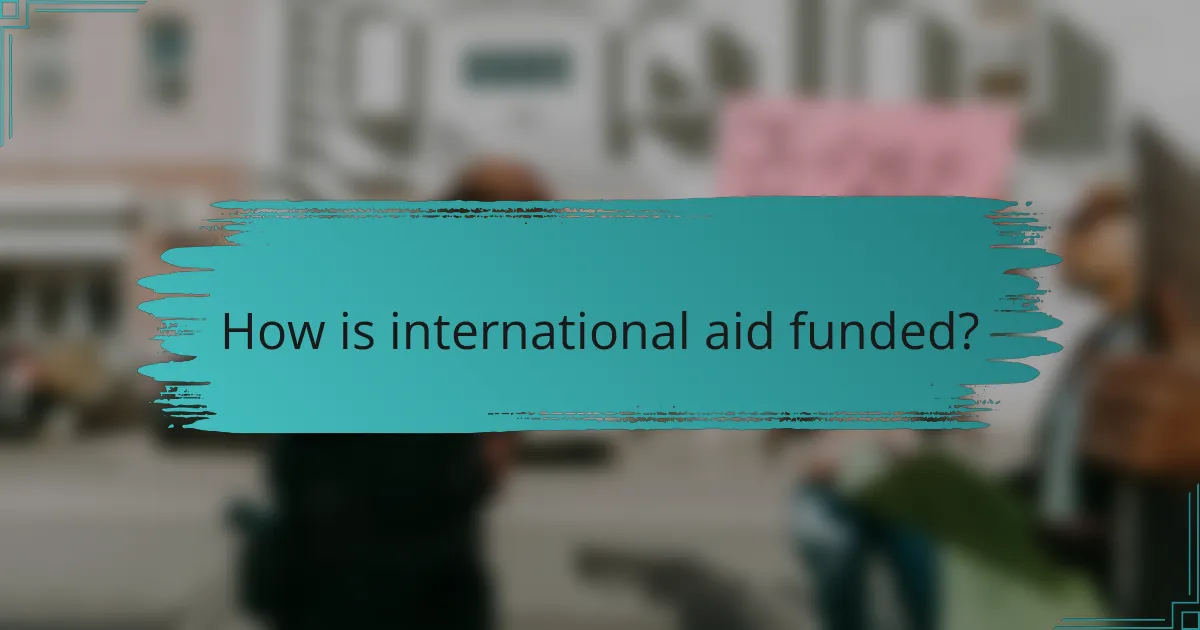
How is international aid funded?
International aid is primarily funded through a combination of bilateral and multilateral sources, private donations, and financial instruments like grants and loans. Each funding mechanism plays a crucial role in supporting various humanitarian and development initiatives worldwide.
Bilateral funding
Bilateral funding refers to financial assistance provided directly from one country to another. This type of aid often reflects the donor country’s foreign policy interests and can be tailored to specific projects or sectors, such as health or education.
For example, the United States Agency for International Development (USAID) allocates funds to various countries based on strategic priorities, often focusing on improving governance or economic development. Donor countries may also attach conditions to their aid, influencing how the funds are used.
Multilateral funding
Multilateral funding involves contributions from multiple countries pooled together to support international initiatives. Organizations like the United Nations, World Bank, and regional development banks facilitate this type of funding, allowing for larger-scale projects that address global challenges.
These funds are typically allocated based on need and effectiveness, with projects ranging from infrastructure development to disaster relief. Multilateral funding can enhance collaboration among nations and leverage additional resources for impactful programs.
Private donations
Private donations are contributions from individuals, corporations, and philanthropic organizations aimed at supporting specific causes or projects. This funding can be highly flexible, allowing for rapid response to crises or targeted interventions.
Examples include donations to non-governmental organizations (NGOs) or crowdfunding campaigns for disaster relief. While private donations can significantly supplement public funding, they may also lead to disparities in resource allocation based on donor interests.
Grants and loans
Grants and loans are financial instruments used to support development projects, with grants typically requiring no repayment and loans needing to be paid back over time. Grants are often provided by governments or international organizations for specific purposes, such as education or health initiatives.
Loans, on the other hand, may come with lower interest rates and longer repayment periods, making them accessible for developing countries. Understanding the terms and conditions of these financial instruments is crucial for effective project planning and implementation.
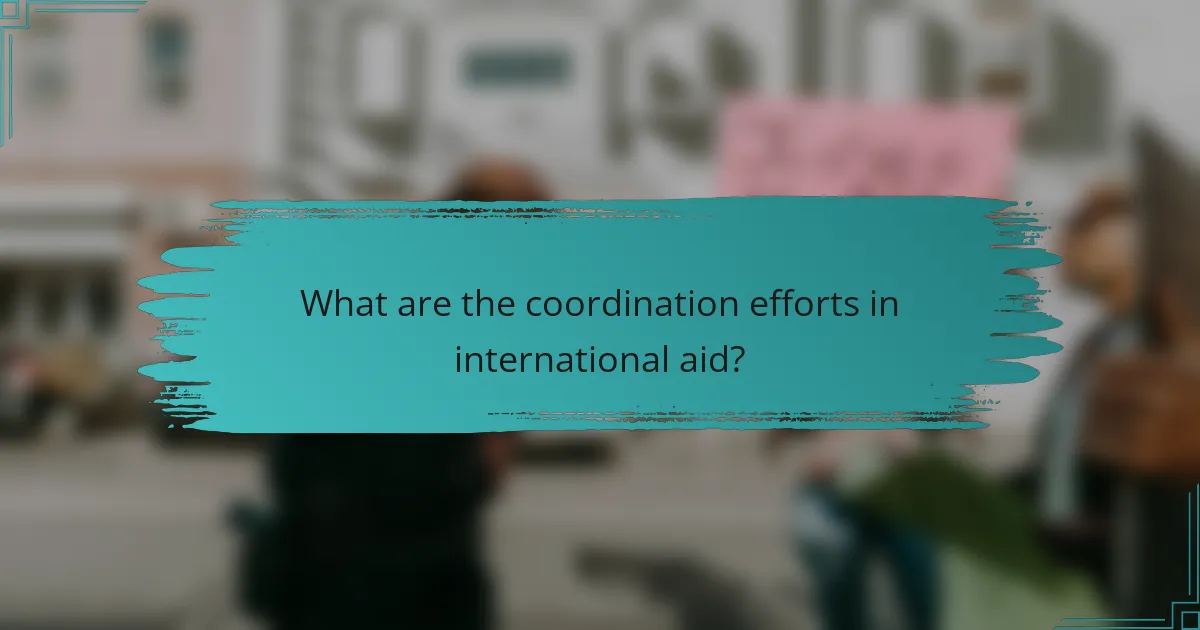
What are the coordination efforts in international aid?
Coordination efforts in international aid involve collaboration among various stakeholders to ensure effective resource allocation and response to crises. These efforts aim to streamline processes, avoid duplication, and enhance the impact of aid interventions on affected populations.
Inter-agency collaboration
Inter-agency collaboration refers to the partnership between different organizations, such as UN agencies, government bodies, and international NGOs, to address humanitarian needs. This collaboration often involves sharing information, resources, and best practices to create a unified response to crises.
For example, during natural disasters, agencies like the World Food Programme (WFP) and UNICEF may coordinate to provide food and nutrition assistance, ensuring that aid reaches those most in need without overlap. Effective inter-agency collaboration can significantly reduce response times and improve outcomes for affected communities.
Local government partnerships
Partnerships with local governments are crucial for the success of international aid initiatives. Engaging local authorities helps ensure that aid is culturally appropriate and aligned with community needs and priorities. These partnerships can also facilitate smoother logistics and access to affected areas.
For instance, in countries like Bangladesh, international organizations often work closely with local government agencies to implement health programs that address specific regional health challenges. This collaboration can enhance trust and foster sustainable development by empowering local governance structures.
NGO coalitions
NGO coalitions are formed when multiple non-governmental organizations come together to amplify their collective impact on humanitarian efforts. By pooling resources and expertise, these coalitions can tackle larger projects and advocate more effectively for policy changes.
An example is the Sphere Standards initiative, where various NGOs collaborate to establish minimum standards in humanitarian response. Such coalitions can help ensure that aid delivery is consistent and meets the needs of vulnerable populations, while also providing a platform for shared learning and accountability among organizations.
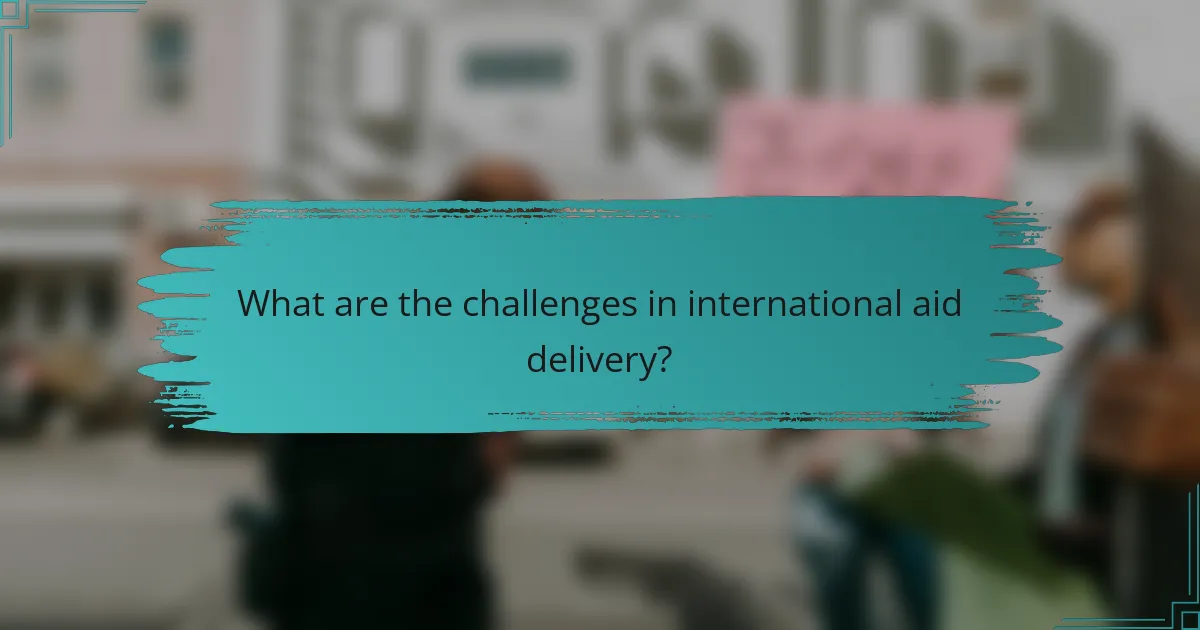
What are the challenges in international aid delivery?
International aid delivery faces several significant challenges that can hinder its effectiveness. Key issues include political instability, resource allocation difficulties, and cultural barriers that complicate the implementation of aid programs.
Political instability
Political instability is a major challenge in international aid delivery, often resulting in unpredictable environments that can disrupt aid efforts. Governments in conflict or transition may lack the capacity to manage aid effectively, leading to misallocation or diversion of resources.
For instance, in regions experiencing civil unrest, aid organizations may struggle to access affected populations safely. This can delay critical assistance and exacerbate humanitarian crises.
Resource allocation
Resource allocation challenges arise when determining how to distribute limited funds and supplies effectively. Aid organizations must prioritize needs, which can lead to difficult decisions about which communities or projects receive support.
In many cases, the competition for funding can create disparities, where certain regions receive significantly more aid than others, even if their needs are comparable. Establishing transparent criteria for allocation can help mitigate these issues.
Cultural barriers
Cultural barriers can significantly impact the success of international aid initiatives. Differences in language, customs, and social norms may lead to misunderstandings between aid providers and recipients, affecting the delivery and acceptance of aid.
To address these barriers, organizations should invest in cultural competency training for their staff and engage local communities in the planning and implementation of aid programs. This approach fosters trust and improves the effectiveness of aid efforts.
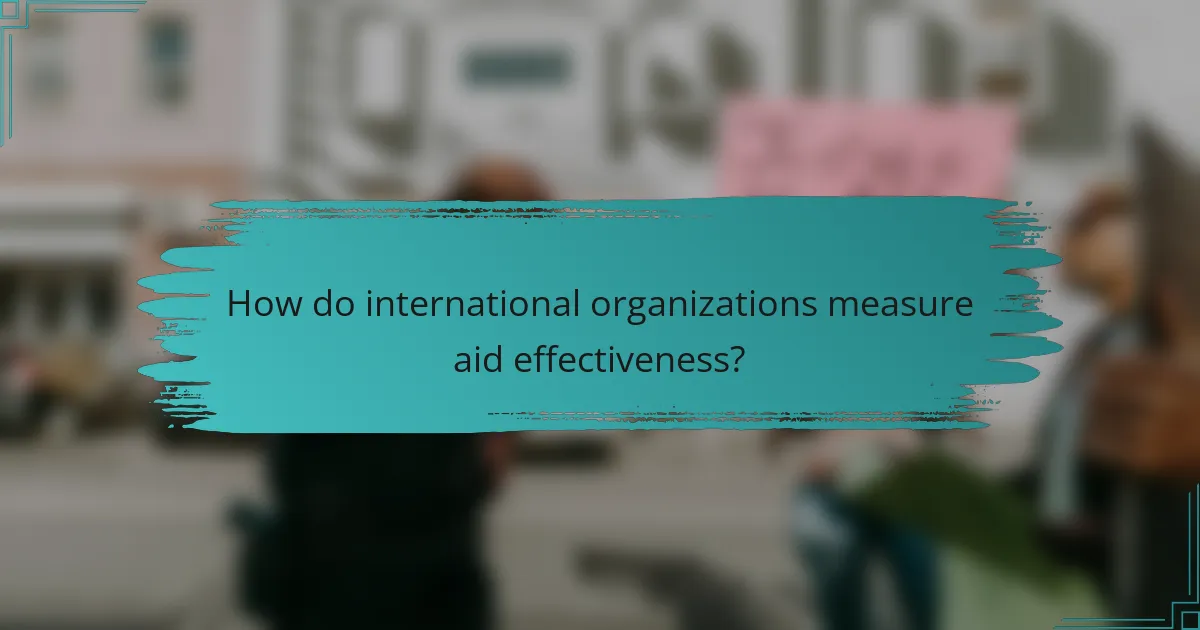
How do international organizations measure aid effectiveness?
International organizations measure aid effectiveness through systematic evaluations that assess the impact of their interventions. These evaluations help determine whether aid achieves its intended outcomes and how resources can be optimized for future initiatives.
Impact assessments
Impact assessments are comprehensive evaluations that analyze the direct effects of aid programs on target populations. They often involve both qualitative and quantitative methods, including surveys, interviews, and statistical analyses to gauge changes in well-being, economic stability, or health outcomes.
Organizations typically conduct these assessments at various stages—before, during, and after aid implementation—to capture a full picture of the aid’s effectiveness. For example, a health program may assess improvements in disease incidence rates among beneficiaries compared to non-beneficiaries.
Performance metrics
Performance metrics are specific indicators used to measure the efficiency and effectiveness of aid delivery. These metrics can include financial ratios, such as cost per beneficiary, as well as outcome indicators like the percentage of projects meeting their objectives.
Common performance metrics include the number of people served, the speed of service delivery, and the sustainability of outcomes. Organizations often benchmark these metrics against established standards or similar programs to identify areas for improvement and ensure accountability.
